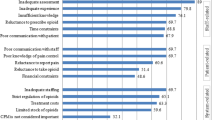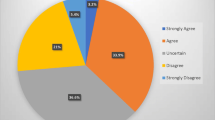Abstract
Purpose
Adequate pain control is essential in cancer treatment. We surveyed Finnish physicians’ perception on their skills and training needs on palliative pain management.
Methods
A structured questionnaire with multiple choices and open ended questions was used for collecting data in 2006–2008. Of 720 physicians participating, 59 were working in oncology and 661 physicians in internal medicine, geriatrics, and primary health care.
Results
The principles of the WHO guidelines of cancer pain management were not well known. Forty-six percent of oncologists and 32% of other physicians (P < 0.0001) knew the analgesic ladder consisting of three steps. Forty-seven percent of oncologists and 61% of other physicians considered pain treatment of cancer patients being well managed in Finland. Only 24% of oncologists and 5% of other physicians considered the education in palliative care being currently at a satisfactory level. Oncologists reported a need of training in interaction and communication skills, ethical questions, and palliative home care. The other physicians expressed the strongest need for training in pain management and palliative care.
Conclusions
To have more confidence in treating cancer, pain physicians would benefit in training and education in palliative care. It should be systematically included both in general and specialist training and continuous medical education.
Similar content being viewed by others
References
van den Beuken-van Everdingen MH, de Rijke JM, Kessels AG, Schouten HC, van Kleef M, Patijn J (2007) Prevalence of pain in patients with cancer: a systematic review of the past 40 years. Ann Oncol 18:1437–1449
Costantini M, Ripamonti C, Beccaro M, Montella M, Borgia P, Casella C et al (2009) Prevalence, distress, management and relief of pain during the last three months of cancer patients’ life. Results of an Italian mortality follow-back survey. Ann Oncol 20:729–735
World Health Organization (1986) Cancer pain relief. WHO Publications Center, Albany
World Health Organization (1996) Cancer pain relief: with a guide to opioids availability-2nd edition. WHO Office Publication, Geneva
Zech DF, Grond S, Lynch J, Hertel D, Lehmann KA (1995) Validation of World Health Organization Guidelines for cancer pain relief: a 10-year prospective study. Pain 63:65–76
Ventafridda V, Tamburini M, Caraceni A, De Conno F, Naldi F (1987) A validation study of the method for cancer pain relief. Cancer 59:850–856
Breivik H, Cherny N, Collett B, de Conno F, Filbet M, Foubert AJ et al (2009) Cancer-related pain: a pan-European survey of prevalence, treatment, and patient attitudes. Ann Oncol 20:1420–1433
Gallagher R, Hawley P, Yeomans W (2004) A survey of cancer pain management knowledge and attitudes of British Columbian physicians. Pain Res Manag Winter 9(4):188–94
Okuyama T, Wang XS, Akechi T, Mendoza TR, Hosaka T, Cleeland CS et al (2004) Adequacy of cancer pain management in a Japanese Cancer Hospital. Jpn J Clin Oncol 34(1):37–42
Pflughaupt M, Scharnagel R, Gossrau G, Kaiser U, Koch T, Sabatowski R (2010) Physicians’ knowledge and attitudes concerning the use of opioids in the treatment of chronic cancer and non-cancer pain. Schmerz 24:267–75
Kaasalainen V, Vainio A, Ali-Melkkilä T (1997) Developments in the treatment of cancer pain in Finland: the third nation-wide survey. Pain 70:175–183
Silvoniemi M, Vasankari T, Vahlberg T, Clemens KE, Salminen E (2010) Physicians' attitudes towards euthanasia in Finland: would training in palliative care make a difference? Palliat Med 24:744–745
Clemens KE, Klein E, Jaspers B, Klaschik E (2008) Attitudes toward active euthanasia among medical students at two German universities. Support Care Cancer 16:539–545
Clemens KE, Jaspers B, Klein E, Klaschik E (2008) Tuition in palliative medicine. Does it have an impact on future physicians' attitudes toward active euthanasia? Schmerz 22:458–464
Kellerman SE, Herold J (2001) Physician response to surveys. a review of the literature. Am J Prev Med 20(1):61–67
Ripamonti CI, Bandieri E, Roila F (2011) Management of cancer pain: ESMO clinical practice guidelines. Ann Oncol 22(6):vi69–vi77
Wolfert MZ, Gilson AM, Dahl JL, Cleary JF (2010) Opioid analgesics for pain control: Wisconsin physicians’ knowledge, beliefs, attitudes, and prescribing practices. Pain Med 11:425–434
Warncke T, Breivik H, Vainio A (1994) Treatment of cancer pain in Norway. A questionnaire study. Pain 57:109–116
Maltoni M, Scarpi E, Modonesi C, Passardi A, Calpona S, Turriziani A et al (2005) A validation study of the WHO analgesic ladder: a two-step vs three-step strategy. Support Care Cancer 13:888–894
Breuer B, Cruciani R, Portenoy RK (2010) Pain management by primary care physicians, pain physicians, chiropractors, and acupuncturists: a national survey. South Med J 103:738–747
Davis MP, Walsh D (2004) Epidemiology of cancer pain and factors influencing poor pain control. Am J Hosp Palliat Care 21:137–42
Deandrea S, Montanari M, Moja L, Apolone G (2008) Prevalence of undertreatment in cancer pain. A review of published literature. Ann Oncol 19:1985–1991
Peker L, Celebi N, Canbay O, Sahin A, Cakir B, Uzun S et al (2008) Doctors’ opinions, knowledge and attitudes towards cancer pain management in a university hospital. Agri 20:20–30
Bailey FA, Burgio KL, Woodby LL, Williams BR, Redden DT, Kovac SH et al (2005) Improving processes of hospital care during the last hours of life. Arch Intern Med 165:1722–1727
Latvala A, Syrjänen K, Salmenoja H, Salminen E (2009) Anaemia and other predictors of fatigue among patients on palliative therapy for advanced cancer. Anticancer Res 29(7):2569–75
Charlton R, Currie A (2008) A UK perspective on worldwide inadequacies in palliative care training: a short postgraduate course is proposed. Am J Hosp Palliat Care 25:63–71
MacDonald N, Ayoub J, Farley J, Foucault C, Lesage P, Mayo N (2002) A Quebec survey of issues in cancer pain management. J Pain Symptom Manage 23:39–47
Rurup ML, Rhodius CA, Borgsteede SD, Boddaert MS, Keijser AG, Pasman HR et al (2010) The use of opioids at the end of life: the knowledge level of Dutch physicians as a potential barrier to effective pain management. BMC Palliative Care 9:23
Cherny NI, Catane R (2003) Attitudes of medical oncologists toward palliative care for patients with advanced and incurable cancer. Report on a survey by the European Society of Medical Oncology taskforce on palliative and supportive care. Cancer 98:2502–10
Disclosures
None
Author information
Authors and Affiliations
Corresponding author
Rights and permissions
About this article
Cite this article
Silvoniemi, M., Vasankari, T., Vahlberg, T. et al. Physicians’ self-assessment of cancer pain treatment skills—more training required. Support Care Cancer 20, 2747–2753 (2012). https://doi.org/10.1007/s00520-012-1396-9
Received:
Accepted:
Published:
Issue Date:
DOI: https://doi.org/10.1007/s00520-012-1396-9




